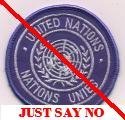Amnesty Encore
by William Norman Grigg
The New American, June 13, 2005
The bipartisan fix is in for an amnesty for illegal immigrants as part of a larger scheme to build a North American “security perimeter."
The American public endures countless lectures regarding the perils of political “gridlock," which supposedly inhibits government's ability to make our lives better. However, sober political observers quickly realize that while gridlock can be frustrating, cooperation across the congressional aisle can be downright deadly. Though partisan acrimony is usually distasteful, the purring rhetoric of bipartisan agreement generally serves as an overture for an assault on the electorate.
Such is the case with the so-called Secure America and Orderly Immigration Act, introduced on May 12 by its chief Senate sponsors, John McCain (R-Ariz.) and Ted Kennedy (D-Mass.), and by its chief House sponsor, Jim Kolbe (R-Ariz.). The McCain/Kennedy bill adapts key elements of President Bush's January 2004 “immigration reform" proposal, which offered (in Mr. Bush's words) “legal status, as temporary workers, to the millions of undocumented men and women now employed in the United States, and to those in foreign countries who seek to participate in the program and have been offered employment here."
Although the president and his allies fiercely object to the description of Mr. Bush's proposal as an “amnesty," the term is an inescapable fit. The same must be said of the McCain/Kennedy proposal as well, which would permit illegal aliens to enroll in a phased program to achieve citizenship. Those wishing to take advantage of the amnesty would — after paying a $2,000 fee and meeting other minimal qualifications — receive a six-year temporary work permit, after which they could apply for permanent residency. Five years later they would qualify for full-fledged citizenship.
Thus the measure would legalize millions of people who chose to violate our nation's immigration laws — at the expense of millions of others who have quietly complied with those laws. McCain/Kennedy would also immediately expand the number of family-sponsored green cards to a formal annual limit of 480,000. However, Title VI of the measure effectively eradicates that limit by exempting “immediate relatives of U.S. citizens" from that tally.
That provision is almost certain to result in radically expanded use of the “anchor baby" gambit. Children of illegal immigrants born in the United States are, in the words of a recent Supreme Court decision, “presumed American citizens." Under Title VI of McCain/Kennedy, the parents would therefore automatically qualify for green cards in the name of “family unity."
It should also be understood that the proposed amnesty itself will draw huge numbers of unemployed aliens to our country. President Bush's January 7, 2004 speech outlining his amnesty proposal created a huge “amnesty rush" at the southern border. Border Patrol agents reported that many of the illegal immigrants apprehended made specific mention of the amnesty proposal.
Amnesty Begets Amnesty
While McCain/Kennedy is unmistakably the progeny of the Bush amnesty proposal, its lineage goes back nearly 20 years. Mark Krikorian of the Center for Immigration Studies observes that the current “reform" proposal is, in essence, “the same as the 1986 Immigration Reform and Control Act: amnesty up front for millions of illegal aliens in exchange for paltry promises of future enforcement — promises that will quickly be abandoned."
“There was a sense then that the law was a grand bargain — closing the back door by prohibiting the employment of illegal immigrants … but tying up the loose ends of prior policy missteps with an amnesty," recalls Krikorian. Based on the 1986 amnesty, we now understand that amnesty creates more “loose ends" than it ties up.
McCain/Kennedy would also create a new temporary visa category — H5-A — “to allow foreign workers to enter and fill available jobs that require few or no skills," according to the official summary. The initial annual limit on H5-A visas will be 400,000, but it will “be gradually adjusted up or down based on demand in subsequent years." Only a fool would wager on a downward adjustment in the H5-A limit, since low-wage labor from Mexico and Central America would be underbid by laborers from Asian countries willing to work for even less.
The Bush amnesty framework envisioned putting the federal government in charge of a human resources management program not only for the U.S. but also, in effect, for the entire world, in the name of pairing “willing employers" with “willing employees." This would require a huge and expanding database of jobs and potential employees. “America's Job Bank," created with assistance from the Department of Labor, is an embryonic form of that federal database.
Under the Bush framework, American businesses would be required to act as appendages of the federal government. Mr. Bush explained that employers “must report to the government the temporary workers they hire, and who leave their employ, so that we can keep track of people in the program.... There must be strong workplace enforcement with tough penalties for anyone, for any employer violating these laws." The McCain/Kennedy proposal duplicates that element of the Bush plan as well.
Beyond opening the floodgates to cheap foreign labor (thereby depressing wage rates) and insinuating the federal government even more deeply into the workplace, the McCain/Kennedy plan calls for huge new wealth transfers from U.S. taxpayers to Mexico “to promote economic opportunity back home and reduce the pressure to immigrate to the U.S.," according to the official summary. It also provides for a “partnership" between Washington and Mexico to improve “health care access so that the U.S. is not unfairly impacted with the costs of administering health care to Mexican nationals." Never mind that the taxpayer shouldn't be forced to pay for Mexicans' health care benefits on either side of the border.
The Next Phase
“Under our plan, America will do its part, but we expect Mexico and other nations to do their part, too, to replace an illegal immigration flow with regulated, legal immigration," insisted Senator Kennedy at the May 12 news conference unveiling the legislation. Judging from the delighted reception given the bill by Vicente Fox, the Mexican government will be eager to do “its part" — namely, continuing to send its unskilled laborers north while receiving extravagant welfare subsidies from U.S. taxpayers.
The repackaged Bush amnesty proposal also received accolades from left-wing labor and activist groups in the United States. Among its supporters are the Service Employees International Union (supporters of left-wing Democratic contender Howard Dean in the 2004 election), the hard-left Association of Community Organizations for Reform, and the Laborers' International Union (LIU). Founded more than a century ago by radical immigrant labor activists, the LIU played a prominent role in the 2003 “Immigrant Workers Freedom Ride," a Marxist-organized caravan of pro-amnesty groups. LIU General President Terence M. O'Sullivan insists that McCain/Kennedy “will strengthen working families across the continent" — an interesting description, given that “mainstream" supporters of the proposal treat it as a means of strengthening U.S. border security.
Another glowing endorsement of the McCain/Kennedy bill (which, recall, builds on a proposal offered by “conservative" Republican George W. Bush) was offered by the Center for Community Change (CCC), a leftist group created in 1968 by disciples of Marxist organizer Saul Alinsky and funded by the Ford Foundation. Through a front group called the Fair Immigration Reform Movement, CCC extolled McCain/Kennedy for “open[ing] the door for further bi-partisan discussion on real comprehensive immigration reform that embraces our principles — to create a path to citizenship for millions of undocumented workers, ensure workers' rights, reunify families, restore civil liberties, protect refugees and asylees [sic], and offer opportunities for safe future migration for families of hardworking immigrants and their families." (Emphasis added.)
Use of the term “migration" tacitly conveys the concept that our national borders should be dispensed with altogether. Significantly, both the Mexican government and the Bush administration have increasingly used the word “migration" in discussions of border policy, a clear illustration of the fact that immigration “reform" is intended to advance the movement toward eradication of our borders. This would certainly solve the problem of illegal immigration — by making all immigrants legal.
Title I of the McCain/Kennedy bill illustrates beyond dispute that the effective abolition of our southern border is the entire purpose of this exercise. Bearing the Orwellian title “Border Security," that section of the bill calls for “development of multilateral partnerships to establish a North American security perimeter and improve border security south of Mexico."
The Mexican government, it should be remembered, zealously guards its southern border, deploying its military to detain and expel illegal immigrants, who are — quite understandably — considered a potential threat to national security. That is, of course, the same Mexican government that routinely denounces any effort by the U.S. to police our own border as a “human rights" offense.
“Major Surgery"
But then again, the concept of a “North American security perimeter" implicitly assumes that the U.S. and Mexico, as well as Canada, our other “NAFTA partner," constitute a single political and economic unit.
Just prior to the recent summit of “NAFTA leaders" in Texas, a tri-national proposal for a “North American Security Perimeter" was published by the Council on Foreign Relations, in collaboration with the Canadian Council of Chief Executives and the Mexican Council on Foreign Relations. Jointly written by former Massachusetts Governor William Weld, former Canadian deputy prime minister John Manley, and former Mexican finance minister Pedro Aspe, the proposal called for, among other things, “harmonization" of visa and refugee policies, an “integrated terror watch list," joint energy and natural resources strategies, a strategy “to stimulate Mexican economic development" (more foreign aid underwritten by U.S. taxpayers), and joint use of “biometric" identification technology.
The concept of a continental “security perimeter" was first proposed by left-wing academic Robert A. Pastor in the January/February 2004 issue of the CFR journal Foreign Affairs. Referring to post-9/11 efforts to bolster U.S. “homeland security," Pastor urged a radically different approach — namely, exploiting “security fears … as a catalyst for deeper integration" among the NAFTA nations. Deeper integration, wrote Pastor, “would require new structures to assure mutual security, [and] to promote trade … [combined with] a redefinition of security that puts the United States, Mexico, and Canada inside a continental perimeter." The McCain/Kennedy plan fits Pastor's prescription perfectly.
According to chief House sponsor Rep. Jim Kolbe (R-Ariz.), the McCain/Kennedy measure — which should be called the Bush/McCain/Kennedy proposal — “doesn't try to solve the hemorrhaging immigration problem with a band-aid. This bill is major surgery." As a proposed “cure" for illegal immigration, the proposal is a grotesque act of political malpractice. Viewed in light of the oath taken by its congressional sponsors, the proposal is tantamount to treason.
Readers are encouraged to write to Congress in opposition to the McCain/Kennedy/Kolbe immigration measure (S. 1033 in the Senate and H.R. 2330 in the House) and all other amnesty bills. For congressional contact information, go to: www.thenewamerican .com/congress/contact.htm



































0 Comments:
Post a Comment
<< Home